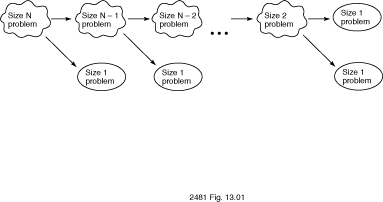
Problems that lend themselves to a recursive solution have the following characteristics:
The recursive algorithms that we write will
generally consist of an IF statement with the form shown below:
IF the stopping case is reached THEN
Solve it
ELSE
Reduce the problem using recursion
END IF;
Figure 13.1 illustrates what we mean by this. Let's assume that for a particular problem of size N, we can split this problem into one involving a problem of size 1, which we can solve (a stopping case), and a problem of size N - 1, which we can split further. If we split the problem N times, we will end up with N problems of size 1, all of which we can solve.
Figure 13.1

Example 13.1
Consider how we might solve the problem of multiplying 6 by 3, assuming that we know the addition tables but not the multiplication tables. The problem of multiplying 6 by 3 can be split into the two problems:
Problem 1. Multiply 6 by 2.
Problem 2. Add 6 to the result of problem 1.
Because we know the addition tables, we can solve problem 2 but not problem 1. However, problem 1 is simpler than the original problem. We can split it into the two problems 1.1 and 1.2, leaving us three problems to solve, two of which are additions.
Problem 1. Multiply 6 by 2.
Problem 1.1 Multiply 6 by 1.
Problem 1.2 Add 6 to the result.
Problem 2. Add 6 to the result of problem 1.
Even though we don't know the multiplication tables, we are familiar with the simple rule that, for any M, M × 1 is M. By solving problem 1.1 (the answer is 6) and problem 1.2, we get the solution to problem 1 (the answer is 12). Solving problem 2 gives us the final answer, 18.
Program
13.1
implements this approach to doing multiplication as the recursive Ada function
Multiply, which returns the product, M x N, of its two arguments.
Program 13.1
FUNCTION Multiply (M : IN Integer; N : IN Positive)
RETURN Integer IS
-- Performs multiplication recursively using the + operator
-- Pre : M and N are defined and N > 0
-- Post: returns M * N
Result: Integer;
BEGIN -- Multiply
IF N = 1 THEN
Result := M; -- stopping case
ELSE
Result := M + Multiply(M, N-1); -- recursion
END IF;
RETURN Result;
END Multiply;
The
stopping case is reached when the condition N = 1 is
True. In this case, the answer is M (M x 1 is
M). If N is greater than 1, the statement
Result := M + Multiply(M, N-1) -- recursive step
executes, splitting the original problem into the two simpler problems:
Problem 1. Multiply M by N - 1.
Problem 2. Add M to the result.
The first of these problems is solved by calling Multiply again
with N-1 as its second argument. If the new second argument is
greater than 1, there will be additional calls to function
Multiply. The recursive step in function Multiply
splits the problem of multiplication by N into an addition problem and a
problem of multiplication by N - 1.
To demonstrate how this function works,
Program
13.2 shows Multiply modified to display the values of its
parameters each time it is called, and the return value before it returns. The
test program prompts the user for two numbers, then calls Multiply.
Program 13.2
WITH Ada.Text_IO;
WITH Ada.Integer_Text_IO;
PROCEDURE Test_Multiply IS
------------------------------------------------------------------------
--| Demonstration of recursive Multiply function
--| Author: Michael B. Feldman, The George Washington University
--| Last Modified: July 1995
------------------------------------------------------------------------
FirstInt : Integer;
SecondInt : Positive;
Answer : Integer;
FUNCTION Multiply (M : IN Integer; N : IN Positive)
RETURN Integer IS
-- Performs multiplication recursively using the + operator
-- Pre : M and N are defined and N > 0
-- Post: returns M * N
Result: Integer;
BEGIN -- Multiply
Ada.Text_IO.Put(Item => "Multiply called with parameters ");
Ada.Integer_Text_IO.Put(Item => M, Width => 1);
Ada.Integer_Text_IO.Put(Item => N, Width => 1);
Ada.Text_IO.New_Line;
IF N = 1 THEN
Result := M; -- stopping case
ELSE
Result := M + Multiply(M, N-1); -- recursion
END IF;
Ada.Text_IO.Put(Item => "Returning from Multiply with result ");
Ada.Integer_Text_IO.Put(Item => Result, Width => 1);
Ada.Text_IO.New_Line;
RETURN Result;
END Multiply;
BEGIN -- Test_Multiply
Ada.Text_IO.Put(Item => "Please enter a integer > ");
Ada.Integer_Text_IO.Get(Item => FirstInt);
Ada.Text_IO.Put(Item => "Please enter a positive integer > ");
Ada.Integer_Text_IO.Get(Item => SecondInt);
Answer := Multiply(M => FirstInt, N => SecondInt);
Ada.Text_IO.Put(Item => "The product of the two integers is ");
Ada.Integer_Text_IO.Put(Item => Answer, Width => 1);
Ada.Text_IO.New_Line;
END Test_Multiply;
Sample
RunPlease enter a integer > 6 Please enter a positive integer > 3 Multiply called with parameters 6 3 Multiply called with parameters 6 2 Multiply called with parameters 6 1 Returning from Multiply with result 6 Returning from Multiply with result 12 Returning from Multiply with result 18 The product of the two integers is 18
Multiply (5, 4). Use a diagram similar to
Figure
13.1.
Copyright © 1996 by Addison-Wesley Publishing Company, Inc.